Results of a comparative evaluation of the fracture toughness parameters K c of cladding pipes from zirconium alloys of type É110 after tests simulating loss-of-coolant accidents at a nuclear power plant are presented. The effect of the content of impurities, alloying elements and structure on the fracture toughness of the zirconium pipes after high-temperature oxidation at 1100°C is analyzed.









Similar content being viewed by others

References
Yu. K. Bibilashvili, N. B. Sokolov, L. N. Andreeva-Andrievskaya, et al., “Thermomechanical properties of oxidized fuel element claddings from zirconium alloys under conditions of loss-of-coolant accidents,” Izbr. Trudy VNIINM, 1, 221 – 139 (2002).
C. Grandjean and G. Hache, “A state of the art review of past programme devoted to fuel behavior under loss of coolant condition,” in: Cladding Oxidation Resistance to Quench and Post-Quench Loads, Part 3 (2008)
S. A. Nikulin, V. G. Khanzhin, A. B. Rozhnov, and V. A. Belov, “Behavior of zirconium cladding pipes of fuel elements of nuclear reactors under extreme operating conditions,” Metalloved. Term Obrab. Met., No. 5, 32 – 39 (2009).
S. A. Nikulin, A. B. Rozhnov, V. A. Belov, et al., “Influence of chemical composition of zirconium alloy É110 on embrittlement under LOCA conditions. Part 1: Oxidation kinetics and macrocharacteristcis of structure and fracture,” J. Nucl. Mater., 418, 1 – 7 (2011).
S. A. Nikulin, A. B. Rozhnov, V. A. Belov, et al., “Zirconium in the nuclear industry, 15th Int. Symp., Sunriver, OR, USA, 24 – 28 June, 2007,” J. ASTM Int., 5(8), 1 – 6 (2008).
S. A. Nikulin at al., “Influence of chemical composition of zirconium alloy É110 on embrittlement under LOCA conditions. Part 2: Macrostructure, oxygen and hydrogen content,” J. Nucl. Mater., in Print (2013).
K. Hellan, An Introduction into Fracture Mechanics [Russian translation], Mir, Moscow (1988), 364 p.
L. D. Landau, A. I. Akhizer, and E. M. Lifshitz, A Course of General Physics. Mechanics and Molecular Physics [in Russian], Nauka, Moscow (1969), 400 p.
A. V. Nikulina, “Zirconium alloys in the nuclear power industry,” Metalloved. Term. Obrab. Met., No. 11, 8 – 12 (2004).
J.-C. Brachet, J. Pelchat, D. Hamon, et al., “”Mechanical behavior at room temperature and metallurgical study of low-tin Zy-4 and M5 (Zr – Nb – O) alloys after oxidation at 1100°C and quenching,” in: TCM on “Fuel Behavior under Transient and LOCA Conditions” Organized by IAEA, Halden, Sept. 10 – 14, 2001 (2001), pp. 1 – 20.
Author information
Authors and Affiliations
Corresponding author
Additional information
Translated from Metallovedenie i Termicheskaya Obrabotka Metallov, No. 2, pp. 52 – 57, February, 2013.
Rights and permissions
About this article
Cite this article
Nikulin, S.A., Khanzhin, V.G., Rozhnov, A.B. et al. Crack resistance of zirconium cladding pipes after high-temperature oxidation. Met Sci Heat Treat 55, 109–114 (2013). https://doi.org/10.1007/s11041-013-9589-5
Published:
Issue Date:
DOI: https://doi.org/10.1007/s11041-013-9589-5



